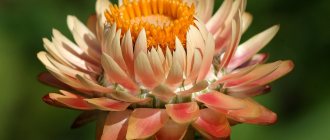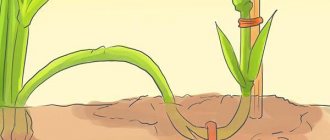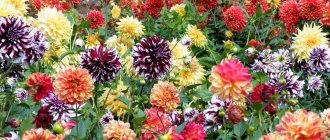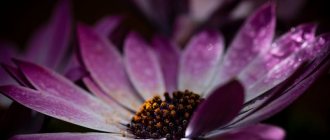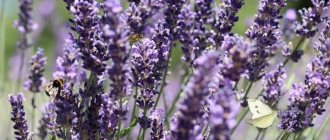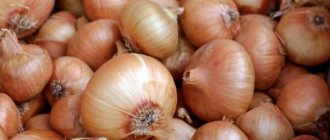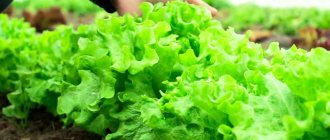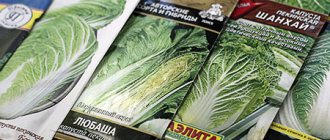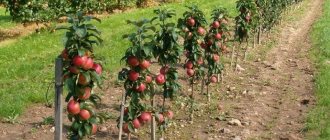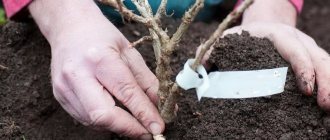The garden plant castor bean (castor bean) got its name due to the fact that its seeds are very similar to mites. In Russia, castor is also called paradise tree and Turkish hemp. Large beautiful carved castor bean leaves can decorate any part of the garden. The plant is popular among gardeners for its attractiveness and ease of care. But even when growing unpretentious crops, it is necessary to follow certain rules for planting and growing from seeds. When and how to properly plant castor beans in open ground and seedlings, you can learn how to grow a beautiful plant in the garden from our step-by-step instructions with video.
Castor bean planting dates by region and lunar calendar
First of all, we suggest that you familiarize yourself with the timing of when to plant castor seedlings in your region. And to find out the favorable days this year according to the Lunar calendar for planting castor beans for seedlings or in open ground, click on the highlighted Link.
Castor bean seeds can be sown in open ground as soon as the soil in the area warms up. In the southern regions - this is the month of April, and in central Russia, Siberia and the Urals - during May.
Since the plant grows quickly, castor bean seedlings should be planted about a month before planting in open ground. Here again you will have to navigate the weather conditions in your region, since young plants are planted in the garden at above-zero temperatures.
You will be interested to know: Transplanting peonies to another place in the fall: how to properly transplant and care
Approximate timing of sowing castor bean seeds for seedlings:
- In the Moscow region and other regions of the Middle Zone - from the third ten days of March to mid-April.
- In Siberia and the Urals - from mid-April to early May.
- In the Krasnodar Territory and other southern regions - during the month of March.
Planting castor beans in the garden
It makes no sense to plant before summer - any cold will destroy a seemingly powerful and large plant. When June begins, the seedlings, having previously been hardened, can be sent to the garden.
Before planting, you need to water the plants in pots well several times so that the entire lump of earth gets wet. It’s hard to believe, but castor beans are afraid of transplantation - the roots are easily damaged and then take a very long time and are poorly restored.
The soaked soil along with the roots must be removed from the pot, without breaking the coma, and moved to the prepared garden hole.
Planting a sprout in the soil
Growing castor beans from seeds
Sowing castor beans for seedlings step by step with video
Castor beans reproduce only by seeds. They do not germinate very well, so it is recommended to treat them before sowing:
- rub with sandpaper;
- soak in any of the growth stimulants, prepare a solution and use the drug according to the instructions.
Sowing castor bean seeds for seedlings step by step:
- Prepare liter containers with drainage holes and fill them halfway with soil for seedlings.
- Place two or three seeds in each container and sprinkle them with a 3-4 cm layer of soil. We sow a few seeds in case some do not hatch.
- Spray the crops with water, cover the container with cellophane and place in a warm place. Check the soil moisture every day and moisten if necessary.
After working with castor beans, be sure to wash your hands!
In about a week, the first loops of seedlings will appear, and immediately place the seedling containers in a well-lit place. If the seeds were soaked in a growth stimulant before sowing, seedlings will appear earlier.
WATCH THE VIDEO: HOW TO PROPERLY PLANT CASTORE BEANS FOR SEEDLINGS
Caring for castor seedlings
After the loops appear and the seedlings are placed on a bright windowsill, the stems will begin to appear, followed by the first leaf. Plants should be immediately removed to a loggia or other cool, bright place. The best air temperature for seedlings is about +15 degrees.
Plants are watered as needed. When the seedlings begin to grow, soil is gradually added to them.
Castor beans grow quickly, so in some cases the seedlings have to be transplanted into a larger container.
To avoid the need to replant, experienced gardeners immediately take a large transparent canister of water as a seedling container. Before sowing, a quarter of it is filled with soil. Since the container is transparent, the seedlings will have enough light. As the castor grows, you will simply need to add soil.
Self-collection of seeds
The castor bean blooms in the middle of summer with huge beautiful flowers. Leaves can reach 1 m in diameter. The beauty of a plant depends on the seeds. You can prepare seed material yourself.
During flowering, you need to identify the largest inflorescences. It is in them that seeds will ripen for future planting.
Peak flowering occurs in August - early September. Some boxes with seeds are already appearing somewhere. At this time, you can start preparing.
Castor bean. How to collect seeds correctly.
- Collect dried seed pods in September.
- Place them in a ventilated place to dry.
- In November-December, remove the seeds from the boxes, breaking them with your hands.
You need to work with gloves. The small thorns on the boxes can hurt your hands.
If the seed material is not completely prepared in time, you can collect it after frost. Select the more mature bolls and cut them with pruning shears.
In the spring, after proper harvesting, castor beans sprout from almost every seed. They lie well and remain viable for at least 4 years.
When and how to plant seedlings in open ground
We must remember that castor bean is a southern plant, very heat-loving. Therefore, seedlings can be transferred to the garden only when stable air temperatures reach +13-15 degrees.
REMEMBER: castor beans die even with slight frosts!
It is better to place this crop in the garden on the south side of the house or fence, where there is the most sun. You can also use it near the house, it is believed that it repels flies. The soil must first be prepared: add humus, peat, humus. Clay soil can be “lightened” with sand and compost.
The procedure for planting seedlings in the soil:
- dig a hole according to the size of the root system;
- apply mineral fertilizers (nitrophoska) in an amount of 30-40 grams;
- carefully place the seedling in the hole to a depth of 8-10 cm;
- fill the hole with earth and make a roller around the perimeter;
- Water the plant generously;
- After absorbing moisture, mulch the tree trunk circle with peat.
Castor bean after flowering
How and when to collect castor bean seeds
If you want to collect seeds from your plants, in the summer, when the castor bean blooms, select the most beautiful tall specimens, most similar to the description of the variety in the professional literature, and mark them. At the beginning of September, cut off the seed pods and place them in a well-ventilated room to dry. The boxes take a long time to dry: the seeds are removed from them in November or December. When pressed, dry capsules simply crumble in your hands, and 2-3 bean-like seeds fall out of them.
Rules for caring for castor beans
You should not water castor beans often, once a week. The plant does not like drought, so one seedling usually requires about ten liters of water, especially during the flowering period. If you provide proper watering, the abundance of colorful castor bean leaves will delight the eye for a long time.
The plant has huge stems and wide leaves that sag from their weight, so you need to tie the stems to a support. Weeds often grow under the leaves and prevent the root system from developing. They need to be removed and the soil periodically loosened.
Landing place
The best place to plant castor beans will be an area in the garden that receives light and warmth.
This plant does not like wind, heavy rains and cold nights. It is better to plant it separately from other plants so that no shadow falls on it. This type of plant is considered decorative, so each owner chooses a place in the landscape according to his own taste. However, it is worth noting that castor beans look good against the backdrop of a trimmed lawn. The soil for planting must be soft and pre-treated. At the same time, despite the unpretentiousness of the plant, it cannot survive without moisture for a long time, so the area for the seedling must be thoroughly moistened. Particular attention should be paid to this when the castor bean blooms.
When choosing a place to plant a seedling, it is necessary to ensure that there are no drafts. This is due to the fact that the castor bean root is of the taproot type, and part of it is located above the soil. Sharp gusts of wind can damage it, leading to the death of the plant.
Properties of castor beans - harm and benefits
The poisonous plant castor bean brings great benefits to humanity, since it contains not only the poison ricinin, but also valuable essential oil. For the sake of this oil, the cultivation of castor beans has acquired an industrial scale. It contains unsaturated glyceride, oleic, stearic, linoleic acids and glycerin, as well as micro- and macroelements magnesium, iron, calcium and potassium. Castor oil, or castor oil, made from oil from castor bean seeds, is used as a laxative in the treatment of constipation, enteritis, colitis and other inflammatory bowel diseases.
It is used externally for bruises, wounds, burns, ulcers, warts and colds. They also treat hemorrhoids and varicose veins. Castor oil is used in the treatment of gynecological diseases and as drops for eye inflammation. Castor oil is produced in capsules and small bottles; it can be stored in the refrigerator for several years in a dark glass container with a tightly sealed stopper.
The beneficial properties of castor beans can provide invaluable assistance in the treatment of endometriosis, and for this you do not need to buy oil, just grind 10 g of plant leaves, pour a glass of boiling water and cook for 15-20 minutes at low boil, then leave for several hours, strain and take for two weeks 1 tablespoon 3 times a day.
If you have a cold or bronchitis, warm castor oil is rubbed into the chest several times a day, after which the patient is warmly wrapped. Wounds, burns, warts, varicose veins and hemorrhoids are treated by daily rubbing the oil into sore spots, and inflamed eyes are instilled with 1-2 drops of oil before bed for 3-5 days.
In cosmetology, castor oil is used to treat hair and scalp, to whiten age spots, to combat wrinkles, skin unevenness, corns and calluses.
Mask to strengthen eyelashes: apply castor oil with a brush to the upper and lower eyelashes, avoiding getting it into the eyes, and after half an hour, remove excess with a napkin. For a noticeable effect, do the procedure daily for a month.
- Pruning hydrangea tree
Mask for problem skin: apply warm oil to steamed facial skin for an hour and a half, then pat your face dry with a napkin and rinse with cold water.
Mask for hair loss: mix equal amounts of oil, fresh lemon juice and alcohol, rub this mixture into the scalp before bed, and rinse thoroughly with warm water in the morning.
Anti-dandruff mask: mix equal parts of oil and calendula tincture, rub into the scalp and rinse after half an hour.
Contraindications: pregnancy at all stages, breastfeeding, exacerbation of any chronic diseases, including chronic constipation, uterine and intestinal bleeding, intestinal obstruction of a mechanical nature, individual intolerance. It is strictly not recommended to use it to treat children under 12 years of age.
Botanical description of castor bean
Botanists consider East and North Africa to be the birthplace of castor beans - it is in Africa that the plant forms impenetrable thickets. In fact, for Africans it is the same weed as hogweed is for us.
Castor beans began to be grown in cultivation at the end of the 18th century - the British were impressed by the appearance of the plant and brought it to Britain to decorate gardens. Of course, castor oil does not tolerate frost and prolonged cold, but the British began to grow castor oil as an annual plant.
In our country, castor beans are grown as an annual plant because the plant does not tolerate frost. Photo: Seedman
Castor oil plant (Latin Ricinus, English Castor Oil Plant) is a monotypic genus of the Euphorbiaceae family. The only species is the common castor bean (Ricinus communis) - an oilseed, medicinal and ornamental garden plant. Castor beans grow best in fertile, loose soil, in a sunny and humid place.
The castor bean variety "Kazachka" is the most common in our country, due to its powerful structure and height of up to 2 m. If you can get foreign varieties of castor beans, then you should buy the varieties "Gibsonii" and "Impala" with large leaves of a bronze hue. It blooms from August to autumn frosts.
Diseases and pests
Castor beans are rarely affected by any diseases due to their toxicity. But pests such as wireworms and bollworms can still harm it.
It is recommended to use broad-spectrum insecticides against them, and, in cases of damage by gray rot, seed mold or fusarium, to treat the seeds with granosan (80%) in terms of 2 grams per kilogram of seeds.
A greater effect can be achieved using silicate glue, which should be diluted in water together with the drug and, in the resulting mixture, pickle the seeds.
Why are castor bean seeds dangerous?
You can often hear that castor beans are poisonous. But many people don’t know what exactly they need to be afraid of and refuse to plant it in their summer cottage.
The plant belongs to the Euphorbiaceae family. Hence the high content of a toxic substance in it - the protein toxin ricin. It is mostly found in seeds. But it is also present in the stem, inflorescences and leaves.
- do not remove seeds in the presence of children;
- put them out of the reach of children;
- keep away from foodstuffs.
Eating seeds can have catastrophic consequences. The lethal dose for a child is 6 pieces, for an adult – 20 pieces!
This flower should not be planted in the yard if there are small children at home. You need to wait until they grow up a little. But even then it needs to be planted in a fenced area.
Exotic castor bean will delight gardeners with its splendor. But it is necessary to take precautions during the collection and storage of seed material. And don’t forget to wash your hands after contact with the plant!
Castor bean (castor bean) is rightfully considered one of the most beautiful ornamental annual plants and is very widely used to decorate summer cottages. But growing it is not so easy.
In order for castor beans to grow healthy, tall and amazingly beautiful, it is very important to use high-quality seeds for sowing. I solved all the problems with castor seeding material very simply - I harvest the seeds myself.
In mid-summer, the beautiful castor bean gains strength, spreads its powerful decorative leaves widely and throws out gigantic and very beautiful flower stalks. Sometimes they can be up to a meter in size!
It is at this time that I choose the two tallest and most beautiful plants that best match all the characteristics of the original variety (color and shape of leaves and peduncles, structure of the bush). The seeds from these castor bean bushes will be collected in the fall.
At the end of August - beginning of September, castor beans reach the peak of their splendor! And on the very first flower stalks, the already formed seed pods begin to dry out. These are what I collect from the plants selected for obtaining seeds and put them in a ventilated pantry to dry.
If the first autumn frosts occur earlier than the required number of seed pods have been collected, this is not a problem. In this case, I use pruning shears to cut off the two most mature peduncles. The seeds contained in them are already quite suitable for use.
I transfer the castor bean seed material, half dried at the dacha, home and place it somewhere in the shade on the loggia for further drying. And only in November-December, when all the gardening work has already been completed and free time is increasing, I begin to extract the seeds.
By this time, all the seed pods are so dry that when kneaded with your hands, they simply crumble into pieces. Removing the seeds is very easy. I break each box directly with my hands and remove 2-3 bean-like grains. You need to wear gloves when working, because you can injure your hands with the small thorns that cover the testes.
This simple work should never be done in the presence of children, since poisoning with the protein toxin ricin contained in these cute and harmless-looking seeds can lead to the most disastrous consequences. The lethal dose for an adult is 20 grains, and for a child - only 6 pieces!
